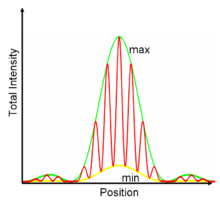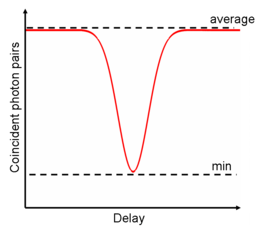Interferometric visibility
The interferometric visibility (also known as "interference visibility" or "fringe visibility" or just "visibility") quantifies the contrast of interference in any system which has wave-like properties, such as optics, quantum mechanics, water waves, or electrical signals. Generally, two or more waves are combined and as the phase between them is changed (e.g. in an interferometer) the power or intensity (probability or population in quantum mechanics) of the resulting wave oscillates (forming an interference pattern). The ratio of the size or amplitude of these oscillations to the sum of the powers of the individual waves is defined as the visibility.
Visibility in optics
In linear optical interferometers like the Mach-Zehnder interferometer, Michelson interferometer, and Sagnac interferometer interference manifests itself as oscillations in the outgoing intensity, also called "fringes". Under these circumstances, the interferometric visibility is also known as the "Michelson visibility" [1] or the "fringe visibility." For this type of interference, the sum of the intensities (or powers) of the two interfering waves equals the average of the fringes. It follows that the visibility can be written as,
This can also be rewritten as
where max is the maximum of the oscillations and min the minimum of the oscillations. If the two optical fields are ideally monochromatic (consist of only single wavelength) point sources then the predicted visibility will be
where  and
and  indicates the intensity of the respective wave. Any dissimilarity between the optical fields will decrease the visibility from the ideal. In this sense, the visibility is a measure of the coherence between two optical fields. A more general formula for this is given by the degree of coherence. This definition of interference directly applies to the interference of water waves and electric signals.
indicates the intensity of the respective wave. Any dissimilarity between the optical fields will decrease the visibility from the ideal. In this sense, the visibility is a measure of the coherence between two optical fields. A more general formula for this is given by the degree of coherence. This definition of interference directly applies to the interference of water waves and electric signals.


Visibility in quantum mechanics
Since the Schrödinger equation is a wave equation and all objects can be considered waves in quantum mechanics, interference is ubiquitous. Some examples: Bose–Einstein condensates can exhibit interference fringes. Atomic populations show interference in a Ramsey interferometer. Photons, atoms, electrons, neutrons, and molecules have exhibited interference in double-slit interferometers.

See also
- Degree of coherence
- Interferometry
- Optical interferometry
- List of types of interferometers
- Hong–Ou–Mandel effect


